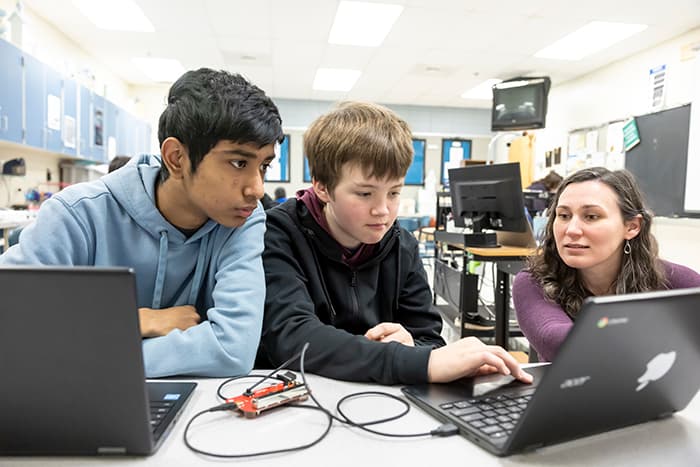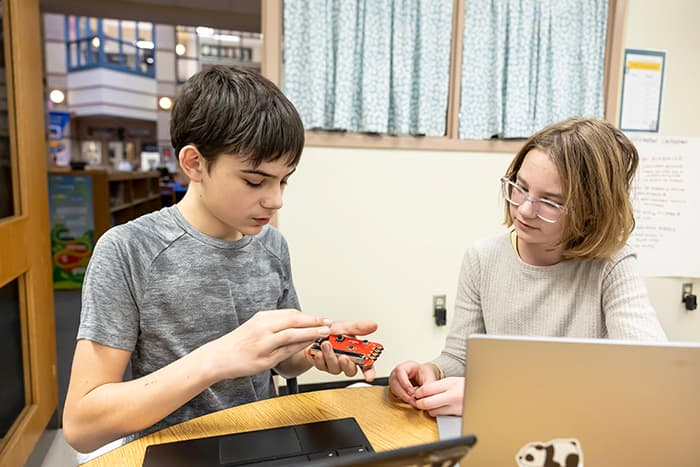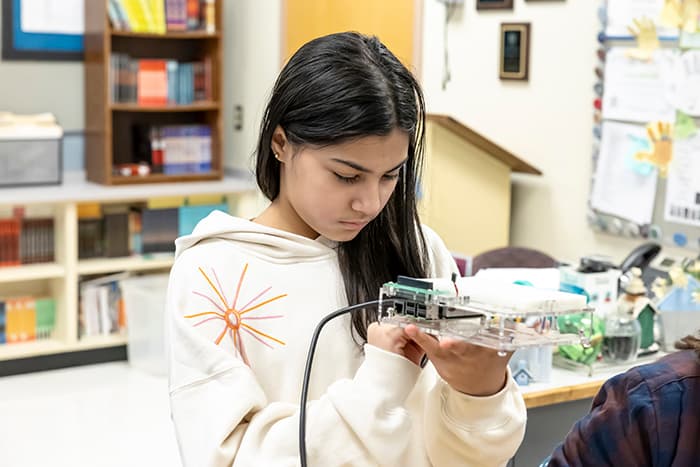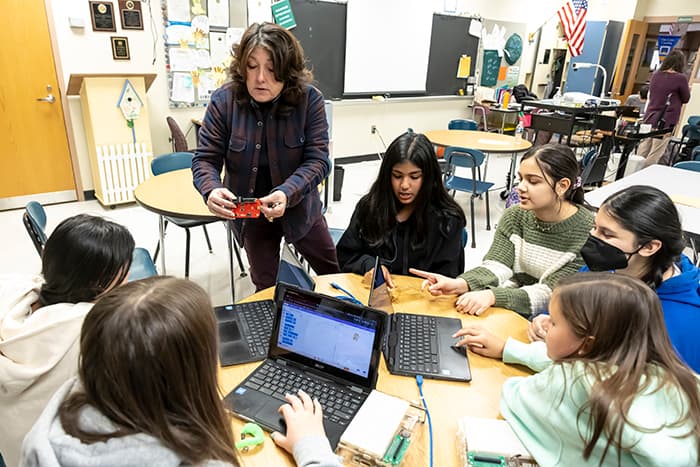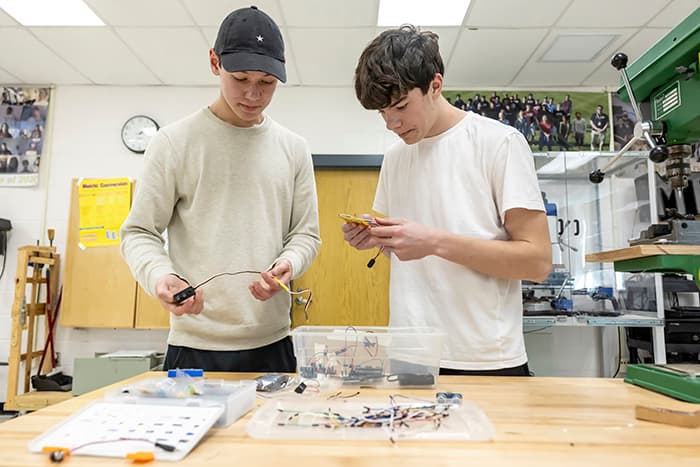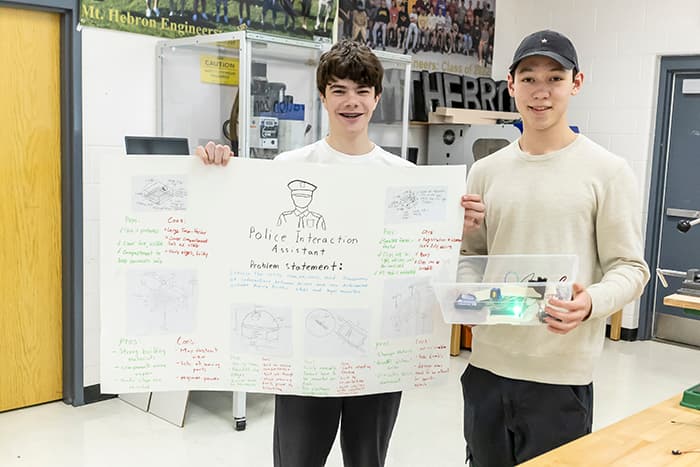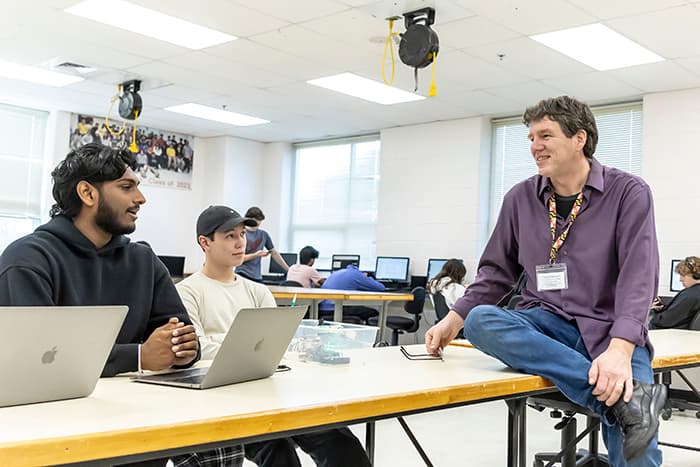HCPSS Students Develop Creative Solutions to Local Problems as Part of National STEM Contest
January 31st, 2024
Lime Kiln Middle School (LKMS) media specialist Stefanie Taylor receives many emails from companies promoting contests for her or her students to participate in. She deletes most of them, but one last fall from Samsung with a $100,000 grand prize caught her eye. Open to public middle and high school students, Samsung’s “Solve for Tomorrow” contest challenges participants to use science, technology, engineering and math (STEM) to identify and develop an innovative solution to a problem in their local community.
“It is really open-ended,” Taylor explains. “The contest basically just requires that students use technology to improve their community. It’s up to them to figure out what problem they want to solve and how to bring technology into the solution.”
Taylor teamed up with LKMS Gifted and Talented (G/T) Resource Teacher Tracy Spillman and a group of LKMS students to enter last year’s contest. Together, they developed a plan to remediate flooding on the LKMS grounds. Their efforts earned the school the top spot in the state-level contest, entry into the national-level contest, as well as a monetary prize package that LKMS was able to use to purchase and upgrade various pieces of technology.
This fall, Taylor and Spillman again assembled a team to compete in the Solve for Tomorrow challenge. Composed of 15 students who are enrolled in Spillman’s “Creative Problem Solving” G/T seminar, this year’s team set out to improve the local environment by developing a sensor that could be used to monitor a so-called “drainage net” used to collect garbage that accumulates at the end of a drain pipe.
“The nets themselves are a relatively new idea. Currently, people have to directly monitor them to determine if they are full or damaged,” Spillman explains. “Our team’s idea was to develop a sensor to do the monitoring, so problems with the drainage nets can be more quickly identified and the nets can be more effective at keeping waste out of our water systems.”
LKMS’ sensor idea earned them a spot in the state level of this year’s contest. They joined teams from Mt. Hebron High School and four other Maryland schools as state finalists, competing to be the top team in the state and move onto the national level.
MHHS juniors Joseph Phelps and Benjamin Fichter headed up that school’s team, which tackled an entirely different problem.
“When someone gets pulled over for speeding, there can be a lot of tension on both sides. The driver worries about what the policeman is going to do, and the policeman worries about what the driver might do. We wanted to come up with something that would help reduce that tension and hopefully lead to better outcomes,” explains Fichter.
Out of this grew their plan to create a device that would enable drivers to share their license and registration information with police officers electronically, over a wireless connection.
“The idea is to make the first interactions between drivers and police officers be contactless and hopefully less contentious,” says Fichter.
The MHHS device wouldn’t eliminate driver-police interactions entirely, Phelps notes. “There would definitely still be a need for those interactions. The device would just help facilitate the initial interaction and hopefully set the stage for more positive follow-up interactions.”
Phelps and Fichter enlisted the help of their MHHS peers in the project.
“We have an incredible team,” Phelps says. “We have kids who are amazing at coding working on some of the technical aspects of the project. We have others who are meeting with police officers to make sure what we’re developing meets their needs. Others are shopping the idea around within the community and trying to spread the word about what we’re doing.”
MHHS Career and Technical Education Teacher Mike Gorleski has also played an important role.
“He’s been there from the beginning, helping us focus, giving us logistical insights, and continually reminding us that the technology we create needs to simplify things, not complicate them,” Fichter says.
While neither the LKMS nor the MHHS team advanced to the national level of this year’s Samsung competition, students say they have learned much from the experience–and that they plan to continue working on their respective projects.
As Phelps notes, “We are all so invested in this work and we want to go as far with it as we can. We really want to see our idea come to life.”
For more information on the MHHS team project, visit https://www.instagram.com/hebron.samsung/.
For more information on the LKMS team project, visit https://sites.google.com/inst.hcpss.org/lkms-conservation-landscape/historical-timeline.
 HCPSS
HCPSS